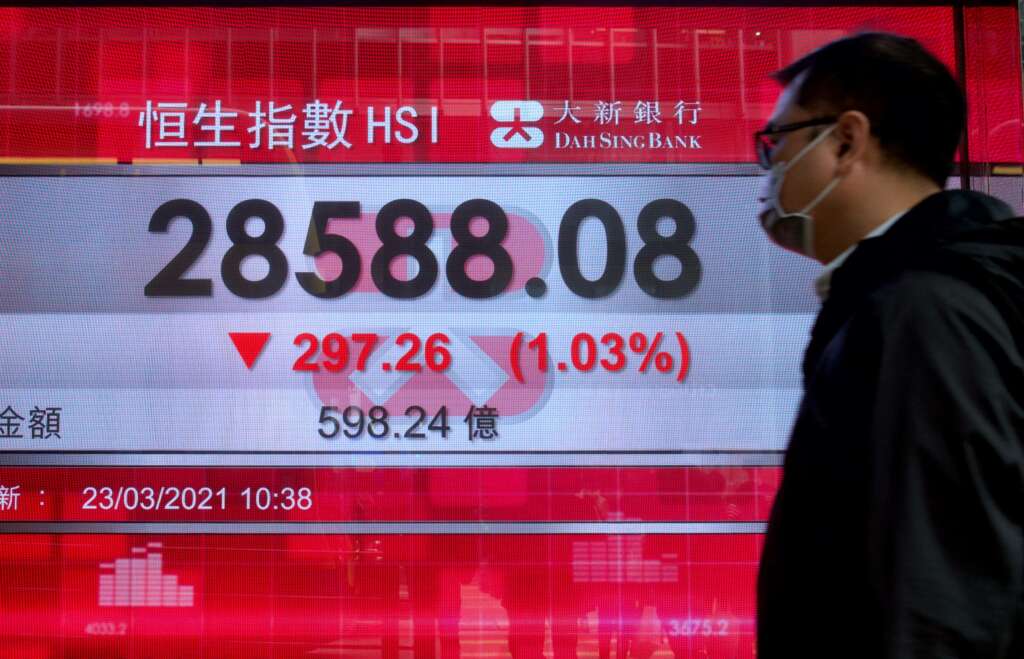
Stocks closed broadly lower on Tuesday and gave back nearly all of their gains from a day earlier as technology, industrial and bank stocks fell.
The S&P 500 fell 30.07 points, or 0.8%, to 3,910.52. Technology stocks were the biggest drag on the market and pushed the Nasdaq 149.85 points lower, or 1.1%, to 13,227.70. The Dow Jones Industrial Average fell 308.05 points, or 0.9% to 32,423.15.
Stocks of smaller companies, which have far outpaced the rest of the market this year, fell even more. The Russell 2000 index gave back 3.6%.
Industrial and health care companies also accounted for a good part of the selling. Energy stocks helped drag down the market too as oil prices fell.
Bond yields declined. That weighed on banks and other financial companies which look to yields as a benchmark for the interest rates they charge on mortgages and other loans.
Investors continue to be focused on the future outlook for the U.S. economy as millions of Americans get vaccinated every day. Investors are wavering between optimism that coronavirus vaccines that might allow business and travel to return to normal and fears of higher inflation after struggling economies were flooded with credit and government spending.
“The market feels like it is in this inflection point,” said Darrell Cronk, chief investment officer of Wells Fargo Wealth and Investment Management. “It’s a good day for reflection.”
The price of U.S. crude oil dropped 6.2% to $57.76 a barrel, pulling energy companies lower. Energy prices have been steadily climbing this year until recently, as the global economy recovers and oil demand worldwide increases while production remains constrained. Marathon Oil fell 6.1%.
Another drop in long-term bond yields pulled bank stocks lower. When bond yields fall they mean lower interest rates on loans such as mortgages, and weaker profits for banks and other lenders. Bank of America fell 2.0% and Wells Fargo dropped 1.9%. American Express slid 2.8%.
The yield of the 10-year Treasury note fell to 1.63%. The yield was well above 1.70% last week, which had put some pressure on the stock market.
The S&P 500 hit a pandemic-era low exactly one year ago, on March 23, 2020, having dropped nearly 34% in about a month. That wiped out three years’ worth of gains. The index wound up roaring back in the coming months, and recovered all its losses by August. Through Monday, it had surged 76% from that low point.
Treasury Secretary Janet Yellen and Federal Reserve Chair Jerome Powell told Congress on Tuesday that more must be done to limit the economic damage from the coronavirus pandemic. Powell also stressed that he does not expect programs aimed at reviving the economy will trigger unwanted inflation.
Cronk said many of the signs in the market point to an early-stage recovery. Interest rates are rising as the economy strengthens, commodities like oil are making steady gains and sectors tied closely to economic growth are doing well. “It’s playing out exactly as it should play out.”
AstraZeneca fell 3.5% after U.S. authorities said that the drug company’s COVID-19 vaccination trial data contained “incomplete” information, which may impact its efficacy. AstraZeneca’s vaccine is being primarily used in Europe.
GameStop, whose stock price soared in January after a social media-fueled frenzy, reported a jump in fourth-quarter profit because of a hefty tax benefit, but the company’s latest results fell short of Wall Street forecasts. The report was released after the close of regular stock trading. The stock fell 3% in after-hours trading.
___
AP Business Writer Stan Choe contributed.
Copyright © 2021 . All rights reserved. This website is not intended for users located within the European Economic Area.
